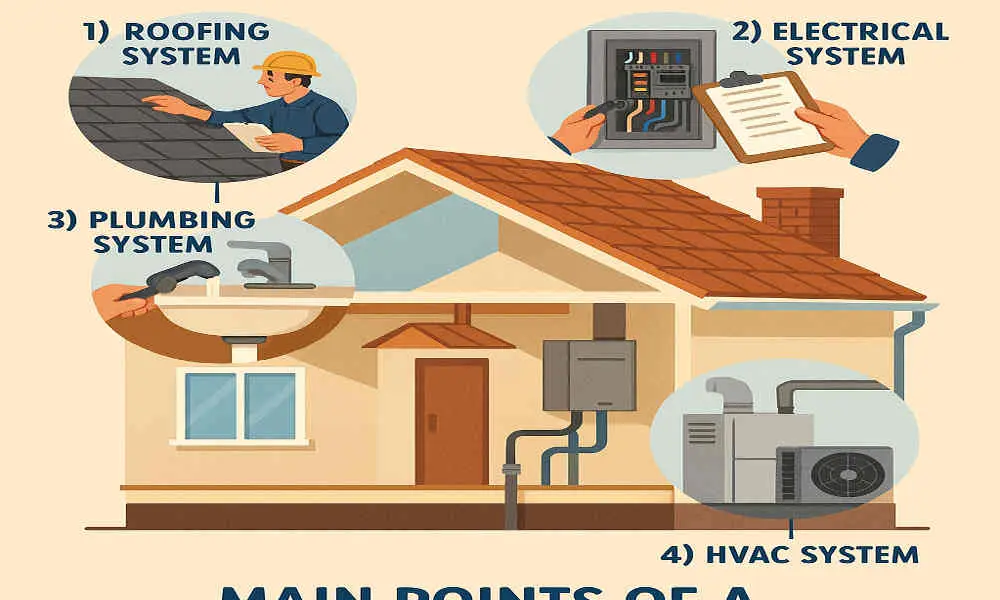When buying or selling a home, one of the most critical steps in the process is the home inspection. This evaluation ensures that the property is safe, functional, and free of major issues. Among the various types of inspections, the four-point real estate home inspection stands out as a focused and essential assessment, particularly for older homes.
But what exactly is a four-point inspection? Why is it important, and who needs it? In this article, we’ll break down the four key components of this inspection—Roofing, Electrical, Plumbing, and HVAC systems—and explain their significance in real estate transactions and insurance coverage. Whether you’re a buyer, seller, or homeowner, understanding these points can save you time, money, and stress.
By the end of this guide, you’ll have a clear understanding of what a four-point inspection entails, how it differs from a full home inspection, and how to prepare for one. Let’s dive in!
What Is a Four-Point Home Inspection?
Definition & Background
A four-point home inspection is a targeted evaluation of four major systems in a home: the roofing, electrical, plumbing, and HVAC systems. Unlike a full home inspection, which examines every aspect of a property, the four-point inspection focuses solely on these critical areas. This type of inspection originated as a requirement from insurance companies, particularly for older homes, to assess potential risks and ensure the property is insurable.
The primary goal of a four-point inspection is risk mitigation. Insurance providers use the results to determine whether a home qualifies for coverage. For example, if a roof is nearing the end of its lifespan or the electrical system poses a fire hazard, the insurer may deny coverage until repairs are made.
Who Needs a Four-Point Inspection?
Not everyone needs a four-point inspection, but it’s often required in specific situations:
- Buyers of older homes: Homes over 25–30 years old are more likely to have outdated systems that need evaluation.
- Homeowners seeking insurance: If you’re applying for a new homeowner’s insurance policy or renewing an existing one, your insurer may request a four-point inspection.
- Real estate transactions: Sellers may conduct a four-point inspection to address issues before listing their property, making it more appealing to buyers.
The Role in Real Estate Transactions
In real estate, a four-point inspection can be a game-changer. For buyers, it provides a clear picture of the home’s condition, helping them make informed decisions. Sellers benefit by identifying and addressing potential issues before listing, which can increase the property’s value and marketability. Real estate agents and insurance companies also rely on these inspections to facilitate smooth transactions and minimize risks.
Deep Dive – The Four Points of a Home Inspection
Let’s explore the four key systems evaluated during a four-point inspection and why they matter.
Roofing System
The roof is one of the most critical components of a home. During a four-point inspection, the inspector evaluates:
- Age and materials: Older roofs or those made from outdated materials may not meet insurance standards.
- Condition: Inspectors look for missing shingles, leaks, and signs of water damage.
- Type: Flat, gable, or hip roofs are assessed differently based on their design and durability.
From an insurance perspective, the roof’s age and condition are crucial. A roof nearing the end of its lifespan may lead to coverage denial or higher premiums. Common issues include inadequate ventilation, sagging, and leaks. Homeowners can prepare by clearing debris, fixing minor leaks, and ensuring proper drainage.
Electrical System
The electrical system is another critical area of focus. Inspectors check:
- Panels and wiring: Outdated wiring, such as aluminum or knob-and-tube, can be a fire hazard.
- Outlets and switches: Inspectors ensure they are functional and meet code compliance.
- Safety concerns: Ungrounded systems or malfunctioning circuits can lead to insurance denial.
To prepare, homeowners should address visible faults, label the electrical panel, and ensure all outlets are grounded.
Plumbing System
The plumbing system includes pipes, fixtures, water heaters, and drains. Inspectors look for:
- Leaks: Even minor leaks can indicate larger issues.
- Materials: Polybutylene and galvanized pipes are red flags for insurers.
- Water heater condition: Age, installation, and functionality are assessed.
Insurance companies are particularly concerned about water damage risks. Homeowners can prepare by fixing drips, checking under sinks, and ensuring proper drainage.
HVAC System
The HVAC system (Heating, Ventilation, and Air Conditioning) is essential for comfort and safety. Inspectors evaluate:
- Components: Units, ductwork, and thermostats.
- Efficiency and safety: Older systems or those with leaks and mold can be problematic.
- Airflow: Inadequate airflow may indicate underlying issues.
To prepare, homeowners should replace filters, clean vents, and ensure the system is functioning efficiently.
Benefits of a Four-Point Inspection
A four-point inspection offers numerous benefits for all parties involved in a real estate transaction:
- For buyers: Gain insight into potential risks and avoid unexpected repair costs.
- For sellers: Address issues in advance, increasing the property’s appeal.
- For insurers: Reduce claims risk by ensuring the home meets safety standards.
- For everyone: Prevent surprises and ensure a smoother transaction process.
Four-Point Inspection vs. Full Home Inspection
Here’s a quick comparison of the two types of inspections:
| Aspect | Four-Point Inspection | Full Home Inspection |
|---|---|---|
| Scope | 4 major systems | Comprehensive (all systems) |
| Typical Use | Insurance approval | Real estate transactions |
| Duration | 1–2 hours | 2–4+ hours |
| Report Detail | Brief summary | Extensive, detailed report |
| Cost | Lower | Higher |
While a four-point inspection is ideal for insurance purposes, a full home inspection is better suited for buyers and sellers who want a complete evaluation of the property.
How to Prepare for a Real Estate Home Inspection
Preparing Each System
- Roof: Clear debris, fix leaks, and inspect the attic for hidden issues.
- Electrical: Address visible faults, check outlets, and label the panel.
- Plumbing: Fix drips, check under sinks, and flush all drains.
- HVAC: Replace filters, clean vents, and test thermostats.
Documentation to Have Ready
- Maintenance records for the roof, HVAC, and plumbing upgrades.
- Previous inspection reports or repair receipts.
Choosing the Right Inspector
Look for inspectors with qualifications, certifications, and local experience. Ask questions about their process and ensure they understand insurance requirements.
Frequently Asked Questions on Four-Point Home Inspections
- Is a four-point inspection required in my area? Check with your insurer or local regulations.
- How long does it take? Typically 1–2 hours.
- Can a home fail a four-point inspection? Yes, if major issues are found.
- How much does it cost? Costs vary but are generally lower than full inspections.
- Does passing guarantee insurance? Not always; additional repairs may be required.
Real-Life Examples and Case Studies
- A homebuyer used a four-point inspection to negotiate a lower price after discovering outdated wiring.
- A homeowner avoided insurance denial by replacing an old roof before the inspection.
Expert Tips to Pass a Four-Point Real Estate Home Inspection
- Schedule regular maintenance for each system.
- Address minor issues proactively to avoid costly repairs.
- Upgrade outdated systems to improve insurability.
Four-Point Inspections and Real Estate Home Inspection Trends
In regions like Florida, where older homes are common, four-point inspections are increasingly required. Insurance companies are also tightening standards, making these inspections more critical than ever.
Conclusion – The Value of a Four-Point Real Estate Home Inspection
A four-point inspection is a valuable tool for buyers, sellers, and insurers. By focusing on the four major systems—roofing, electrical, plumbing, and HVAC—it ensures safety, functionality, and insurability. Whether you’re buying, selling, or maintaining a home, scheduling a four-point inspection can save you time, money, and stress. Don’t wait—book your inspection today!




